Toronto Rehabilitation Institute/University Health Network
The Challenging Environment Assessment Laboratory (CEAL) facility was developed under the guidance of IDT, who served as Integration Manager. The specifications of each major system, sub-system and several detailed pieces of equipment were created by IDT. Our well-known “zero-gap” integration policy was applied by which the technical properties and interface requirements of each of these component assemblies is specified, including the method of integration with adjacent systems. As a result, the project could be integrated in a closely-knit manner, with each piece matching and mating with its adjacent counterpart.
In 2003, the Toronto Rehabilitation Institute (TRI) approached IDT to consider developing a plan for a flexible, multi-purpose research environment. Following interviews with the stakeholders of the project (orthopaedic surgeons, therapists, designers of assistive devices), a plan was created to build a unique laboratory which could house a multi-function simulator. This became known as the Challenging Environment Assessment Laboratory (CEAL). This grew to be part of a major research makeover of TRI entitled ‘iDapt’ – a new Centre of Excellence in rehabilitation research addressing a multitude of issues, from hospital to home.
IDT developed a comprehensive research and infrastructure proposal, which was submitted to the Government of Canada and the Province of Ontario. One year later, the project was granted.
Through a close collaboration between TRI and IDT, as well as several industrial partners, the development of CEAL began. Challenges to dibbled and elderly persons would be among the key areas of study, These challenges include:
• Mobility on stairs
• Mobility on slippery/icy surfaces in level or sloping conditions
• Mobility in street environments
• Driving safely.
An essential area of research common to most of these is falls. In the presence of challenges, falls can lead to major health issues including injury or death. Falls can also force people to re-locate from their homes, enter long-term care, disrupt the work force, raise insurance costs, and simply make life miserable. Therefore, a major focus was placed on “simulating and stimulating” falls in a safe, controlled manner.
A second area is driving: As the population demographically ages, the number of elderly-driver incidents increases. What are the impacts of visual degradation, the reliance on medications with their sedative side-effects, the loss of cognition, or reduced physical ability on driver safety? What can be done to improve the car, the road, the licensing standards, or even training?
To cover all these areas while providing a suitably flexible research capability is a daunting task. As the analysis proceeded, it became clear that a simulation facility with multiple, modular labs would be required, covering each of the subject areas.
The resulting centre was then created below the TRI hospital facility (the hospital’s west wing was demolished in order to allow the construction of CEAL). Over the course of eight years, the laboratory and the simulator equipment took shape.
In 2019, Toronto General Hospital was named among the world’s Top 10 Hospitals by Newsweek magazine. It was ranked first on Canada’s Top 40 Research Hospitals list for 2018, and has been consistently ranked at the top since the rankings began by Research Infosource Inc. in 2011.
CEAL Objectives
The Challenging Environment Assessment Laboratory is currently the world’s only simulation facility in which all of the challenge areas of rehabilitation can be studied to this high level. An essential element of the function of this laboratory is its ability to perform all analyses- from patient studies to data analysis – in-house, develop, build, test prototypes in an advanced workshop with rapid prototyping capability, and recommend enhancements to standards. As an example, the research conducted in StairsLab has led to significant changes to the Canadian Building Code that greatly reduce the risk of stair-related falls
CEAL Features
The CEAL laboratory is a dream-come-true for the rehabilitation researcher who seeks realistic facilities in which to conduct accurate and repeatable scientific research. The main systems in the lab include:
StairsLab
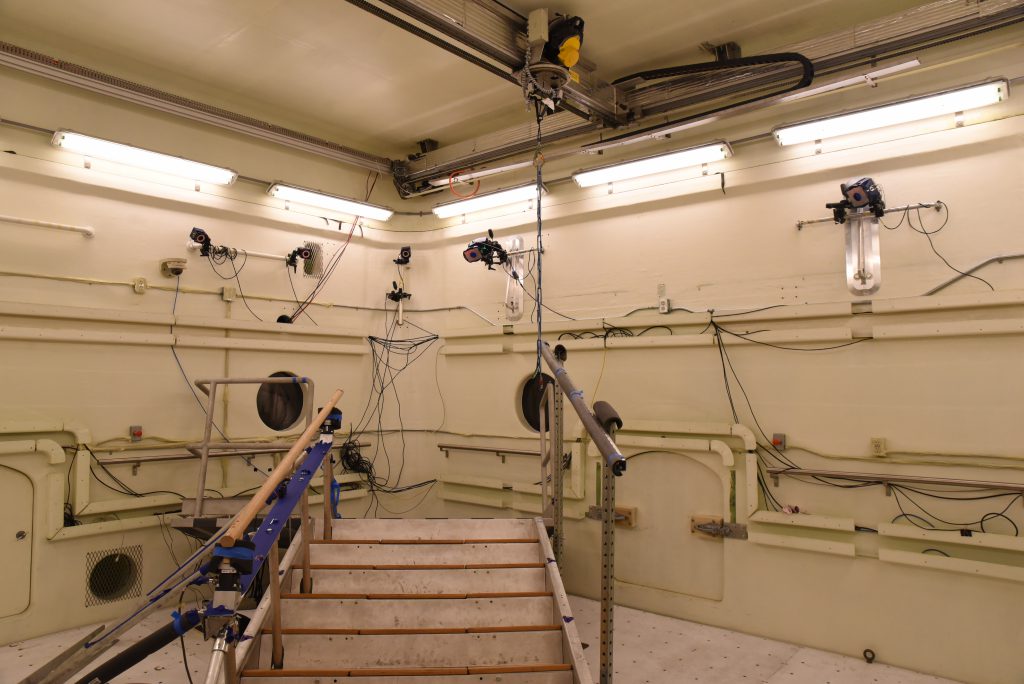
This 6m x 6m module can be fitted with a variety of staircases with varying properties (tread shapes, sizes, handrails) to investigate human behaviour and balance on staircases. Within the floor surface, flexible attachment points are provided, enabling the research project to develop unique interfaces to test products or concepts. The entire space is monitored with high-performance marker-based motion capture, as well as video and audio.
Research projects have included developing new guidelines and building codes for stairs to reduce the risk of falls. Secondly, several novel ideas have been tested in StairsLab, including the safety analysis of patients with varying mobility in bathroom environments.
StairsLab can be installed on the CEAL Motion System to create realistic tilt or disturbance perturbations, or used-stand-alone. It contains its own network of real-time feedback loops that monitor physiological, gait and musculoskeletal parameters.
WinterLab
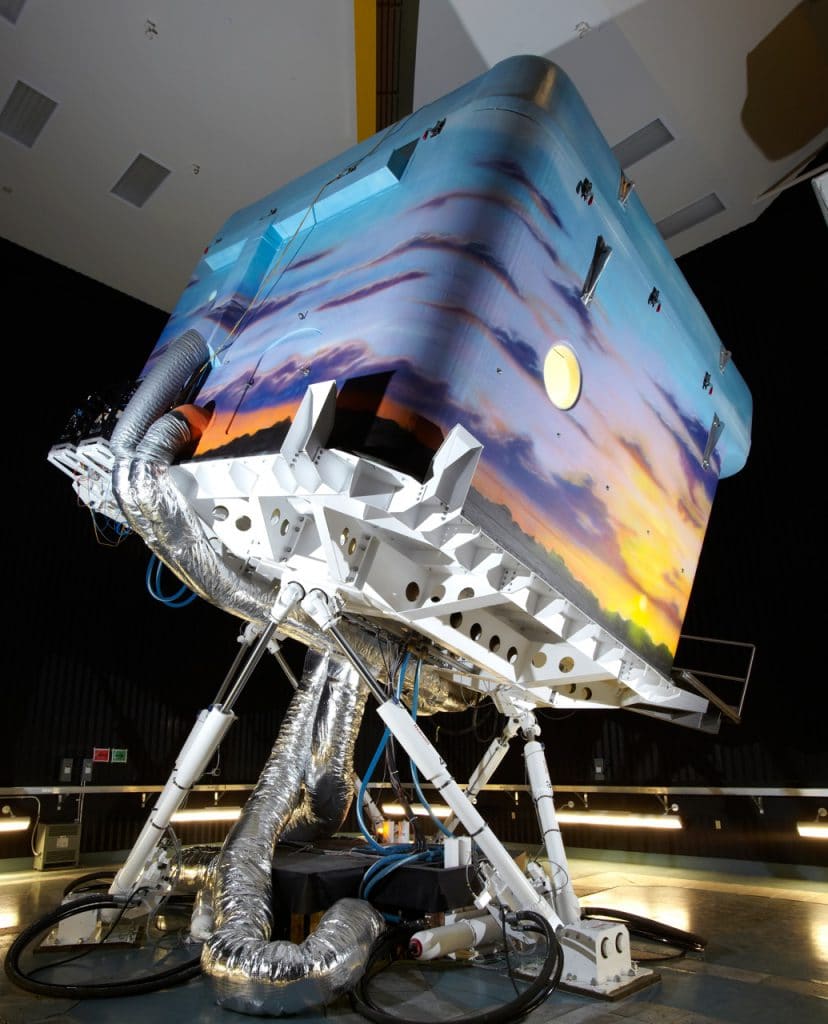
When snow falls in Toronto, so does Toronto. Injuries escalate, and the health-care system must deal with an influx of patients with injuries. A commonly-thought solution is to go to the local store and but “winter-rated” boots. However, a rating is only as good as the value of the test that wrote it.
Instead of a “boot-on-ice” test, WinterLab offers research a complete in-situ environment to test under realistic conditions. Real snow, real ice, real wind and real cold are created within the insulated 6m x 6m laboratory. In fact, the floor is an ice rink built by the maker of Canada’s famous National Hockey League venues. In developing WinterLab, there were several technical challenges. Ice is heavy, brittle and a natural material. Ensuring the ice would maintain its shape while the floor was subjected to motion posed a design challenge
Fall Arrest System
The greatest challenge of all was the assurance of safety: whereas most high-performance motion simulators are operated by healthy pilots who are strapped into seats, WinterLab would be utilised by persons including frail, elderly patients with walking and balance challenges – while standing on a slippery ice surface. Hence, a specialised safety harness and fall arrest system had to be created. An X-Y gantry system of rails is mounted in the roof cap of the module, which supports a vertical fall arrest mechanism. This ensures that the person can always be supported by an active/passive fall prevention system.
WinterLab can be installed on the CEAL Motion System to create realistic tilt or disturbance perturbations, or used-stand-alone with its own tilting mechanisms. Temperatures can be lowered to -10C. It contains its own network of real-time feedback loops that monitor physiological and musculoskeletal parameters.
StreetLab
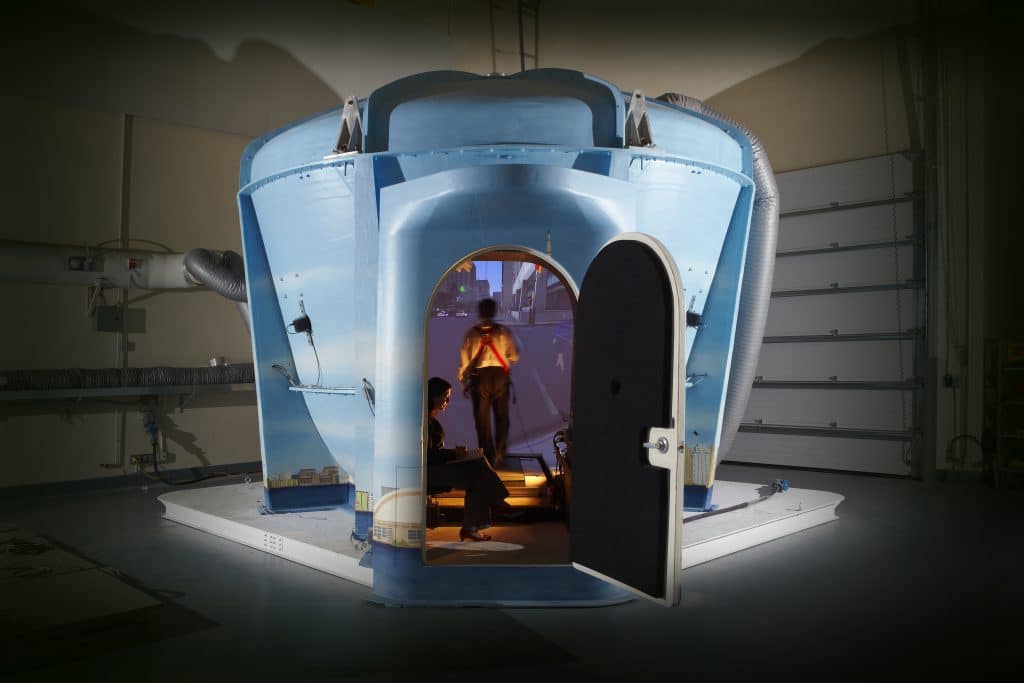
Crowded, busy streets can be an extremely challenging environment for some persons. The ability to walk or move in a wheelchair can be impaired by physical challenges (slopes, uneven surfaces), or psychological stimuli (noise, traffic).
IDT created StreetLab as one of the modules of the CEAL simulator, with the aim of reproducing the walking or movement of a wheelchair through a crowded city environment. Reproducing realistic street environments is however a significantly challenging task. The observer must feel surrounded by both visual and audio, while moving in a realistic manner. Users should recognise the environment, which should change as a function of the user position. Hence, it should be highly interactive, and create the perception of movement.
The resulting simulator module is a unique optimisation of several technologies:
• The user is placed in the middle of a surround dome on a treadmill, painted white to allow image projection.
• A database of accurate downtown Toronto is created, representing the details of buildings, roads, signage, pedestrians, vehicles, and the associated sound which each of these produces.
• A high-resolution image is projected over a wide horizontal and vertical field of view, including on the treadmill.
• Surround sound represents the tone and spatial orientation of noises in the environment.
• As the user walks, the world moves in the opposite direction.
• The user is safely secured on a vertical fall arrest system and wears a safety harness.
The dome of StreetLab is no ordinary projection dome! It is lined with a special material that absorbs sound (to cancel the echo), while providing a suitable surface for the projection of the imagery. This was perhaps one of the biggest technical challenges, solved with an innovative use of materials and construction techniques.
StreetLab is used for studies into human walking behaviour of patients with physiological and cognitive challenges.
FallsLab
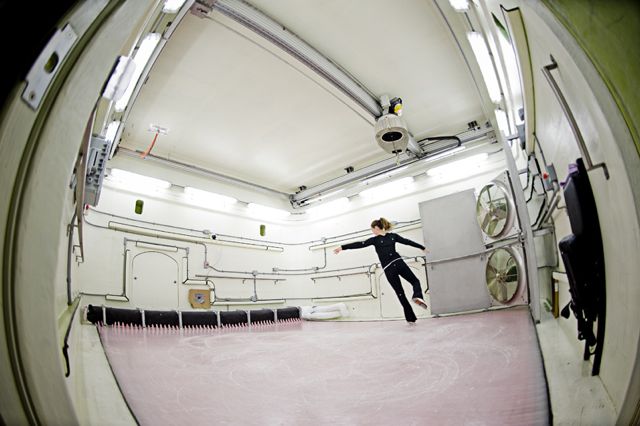
Falls are a major problem around the world as they lead to major disruptions to peoples’ lives, ability to work, and their well being. Understanding the mechanisms of falls under varying conditions is critical to proposing solutions, which may include assistive devices, shoes that help compensate for reduced balance, or other technologies.
IDT created FallsLab on the 12th floor of Toronto Rehabilitation Institute. This is a dynamic platform capable of high accelerations in the lateral X-Y plane. A system of force plates and motion capture sensors precisely record the patrons reaction to the input stimulus. The mechanism, driven by timing belts, provides a powerful yet safe method of measuring the response of human subjects under varying conditions.
CareLab

The Toronto Rehabilitation Institute also required a realistic environment in which to test hospital equipment related to the lifting caring for patients. The objective was to test new lifting devices, wheelchairs and other equipment that is part of care facilities.
The resulting “CareLab” is a copy of a typical hospital room, enabling researchers to experiment with the physical movement and treatment of patients. An example product developed in CareLab is a pneumatically-driven sling insertion device that enables hoisting patients from the bed without having to lift the patient by the caregiver’s hands.
HomeLab
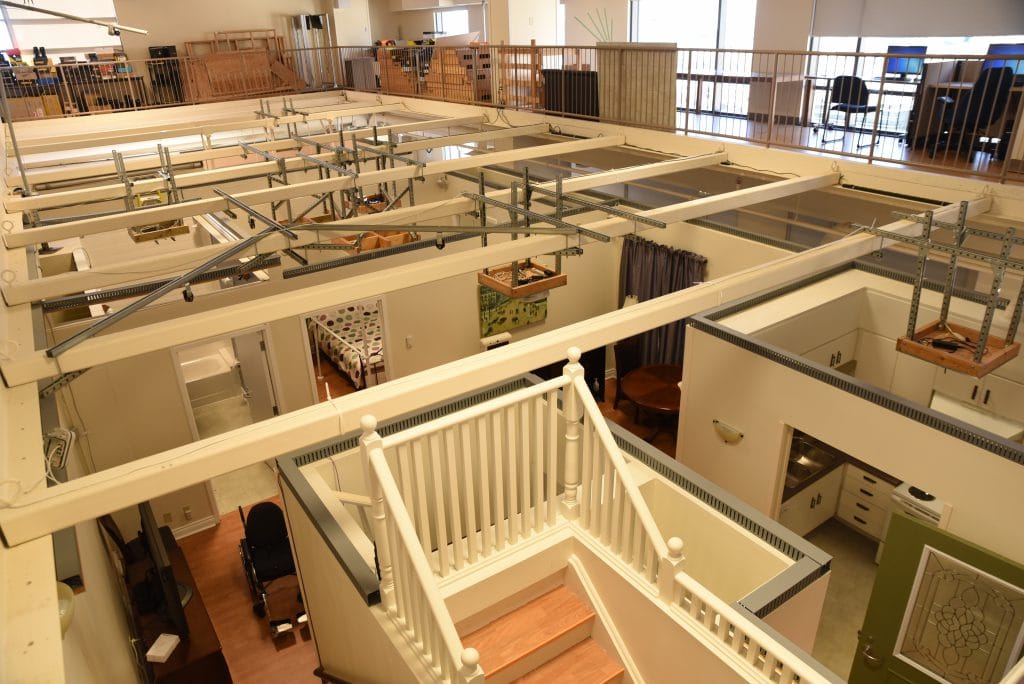
With a growing ageing population, there is an increasing societal interest to keep people in their homes for as long as it is possible, while maintaining their safety and comfort. Ageing persons may find themselves increasingly less able to move about and carry out household activities safely. Patients convalescing in their own homes, after returning from an operation, may be confronted with mobility and safety challenges. Persons with dementia may face challenges in carrying out mundane tasks.
The most suitable way of studying homes is to create a simulated home. This is what HomeLab in fact provides – a representative home environment, with all the main features of typical Canadian dwellings. Yet, it has several research features which make it special: It has no hard ceiling, and researchers can observe ongoing activities from the gallery above. It is fully instrumented, enabling researchers to monitor patient movement and physiological parameters. It is also designed to enable rapid changes to configurations, thereby allowing questions to be answered regarding new concepts.
One development facilitated by HomeLab was the fall detection system, which detects when a resident in the home has fallen and is potentially in need of help. The device, after identifying the fall, communicates with the patient and, through the answers given (or lack thereof), determines the kind of help or assistance that is required.